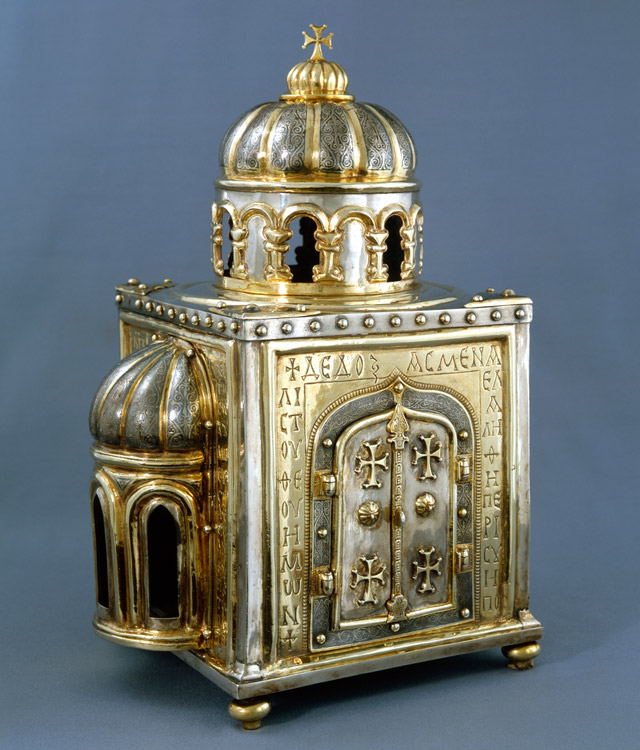Artophorion (Reliquary of St. Anastasios the Persian)
Aachener Dom, Schatzkammer

 Select the image to zoom
Select the image to zoom
This precious silver object with its central dome rising above an arcaded drum, its small apse pierced by long windows and its large portals decorated with applied crosses, is made in the shape of a small but elaborate Byzantine church. A dedicatory inscription framing the apse of the "church" invokes the Lord's help on behalf of a certain Eustathios, a highly decorated Byzantine official, who served as military commander of Antioch, a city in northern Syria, and Lykandos, a district in eastern Asia Minor in 969/70. Three further inscriptions taken from the Book of Psalms surround the ogival doorframes. The Psalm verses chosen may be construed to interpret the precious container as an image of the Heavenly Jerusalem, thus suggesting that it originally functioned as an Artophorion, a container for the Eucharist.
Nothing is known about the circumstances under which the object arrived at Aachen, but it seems likely that it was brought there by a German cleric or nobleman, who acquired it in Constantinople or Antioch during the twelfth or thirteenth century. At Aachen, the precious container never served as an Artophorion, but was used to enshrine the head of the Persian martyr-saint Anastasios (d. 628). The circumstances of this adaptation are, once again, obscure. The Byzantine object may simply have been appropriated on account of its shape, lavish decoration, and Eastern provenance, shortly after its arrival to serve as a new container for an existing relic of St. Anastasios. It is also possible that the object contained a newly acquired relic of the head of St. Anastasios when it arrived at Aachen. As recorded in the pilgrim's account of Antony of Novgorod of ca. 1200, the body of St. Anastasios (his head having previously been stolen) was venerated in the Church of St. Luke in Constantinople. While it is impossible to prove that the relic described by Antony is in fact the one later venerated at Aachen, the church-shaped container of Eustathios may well have been used as an appropriate means to attest the origin and authenticity of its sacred content at a time, when many relics with uncertain provenances arrived in western Europe as sacred commodities or loot from the eastern Mediterranean.




